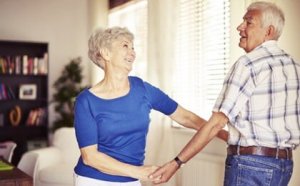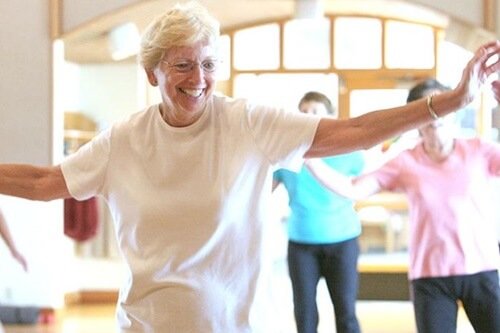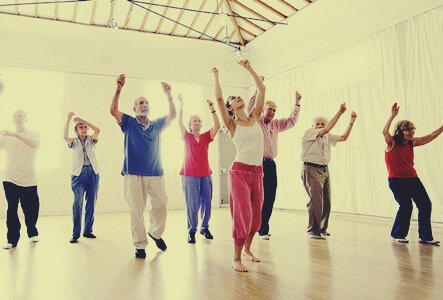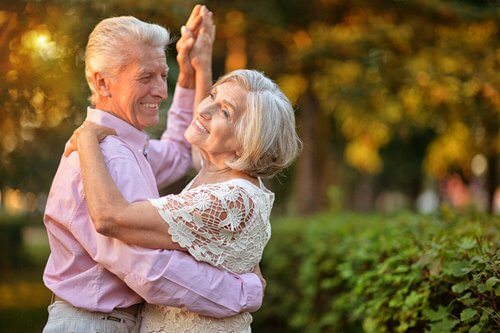The Benefits of Dance in Old Age


Written and verified by the psychologist Valeria Sabater
Dance has many benefits in old age. Physically, it improves mobility and balance and can keep joints from going stiff. It also has emotional benefits because it’s a source of joy, confidence, and motivation. Dance helps keep a lot of older people from swimming in seas of negative emotions.
Poet Charles Baudelaire said that one way to demystify music is to channel it through dance. This is something anyone who has danced knows. But some people never try dancing until they’re already in their 60s or 70s.
Dancing can be a physical and emotional reawakening for some people. It’s important not to forget how important it is to find sources of motivation in old age. As you probably know, that kind of thing can really increase a person’s life expectancy.
Our image of the elderly has changed a lot in recent years. Now many of us can picture active people who are still willing to explore, try new things, and grow as people. Dance is an amazing way to improve physical health and also a great excuse to be in a social environment and connect with other people.
“Every dance you make belongs to you. It is part of your collection. When you think of it like that, you’ll want to make your next routine the best you’ve ever made!”
-Torron-Lee Dewar-

What are the benefits of dance in old age?
No one can stop aging. But that doesn’t mean it has to be a constant state of decline. Everyone confronts this part of life differently depending on their mindset, resources, habits, and health.
Prevention is a big thing to keep in mind. Having specific daily strategies to fight aging can ensure a great quality of life. Things like a healthy diet and having a social support network will ensure you reach old age happy and in good health.
If an older person has never danced before, it’s worth encouraging them to try it out. Below, we share some of its potential benefits.
Dancing improves the quality of life of people with Parkinson’s
A study carried out by the University of Washington School of Medicine showed that dance has major benefits for people with Parkinson’s disease. They think it can help a great deal with some of the following issues:
- It may help them fall less often.
- Improving movement, rhythm, speed, and flexibility.
- Strengthening and toning muscles.
- Strengthening cognitive processes like attention and memory.
- Improving self-esteem.

It reduces depression-related symptoms
Doctors Amanda Haboush and Mark Floyd from the University of Nevada carried out a study on a few retirement homes with dance programs. A lot of the residents with mood disorders showed improvement after just two weeks of dancing. They felt less depressed and had less stress, anxiety, and insomnia issues.
Like we said earlier, prevention is an important part of the aging process. A great way to find new sources of energy in old age is to go to a dance center. It’s hard to deny the benefits of doing so, like connecting with other people, fighting loneliness, and preventing things like apathy and lack of motivation.

A body in motion makes the brain happy
A body in motion sharpens your senses and connects you with yourself and your surroundings. Dancing to music lights up your brain and gives you some extra serotonin and endorphins. It also makes you laugh, pay attention, forget your physical pains, and gives the world meaning.
A Saint Louis University study showed that two dance sessions a week for two months allowed elderly people to reduce their inflammation medication. They also had reduced arthritis and arthrosis pain and became more agile and quicker.
Researchers also say that dancing is good for the brain because it combines aerobic exercise and neural activity. It forces you to make quick decisions, which strengthens your neural networks and, more importantly, helps you create new ones.
The benefits of dance in old age clearly have scientific backing. They’re also more than evident to both those who have been doing it their whole life and even to those who are just starting out.
Dance has many benefits in old age. Physically, it improves mobility and balance and can keep joints from going stiff. It also has emotional benefits because it’s a source of joy, confidence, and motivation. Dance helps keep a lot of older people from swimming in seas of negative emotions.
Poet Charles Baudelaire said that one way to demystify music is to channel it through dance. This is something anyone who has danced knows. But some people never try dancing until they’re already in their 60s or 70s.
Dancing can be a physical and emotional reawakening for some people. It’s important not to forget how important it is to find sources of motivation in old age. As you probably know, that kind of thing can really increase a person’s life expectancy.
Our image of the elderly has changed a lot in recent years. Now many of us can picture active people who are still willing to explore, try new things, and grow as people. Dance is an amazing way to improve physical health and also a great excuse to be in a social environment and connect with other people.
“Every dance you make belongs to you. It is part of your collection. When you think of it like that, you’ll want to make your next routine the best you’ve ever made!”
-Torron-Lee Dewar-

What are the benefits of dance in old age?
No one can stop aging. But that doesn’t mean it has to be a constant state of decline. Everyone confronts this part of life differently depending on their mindset, resources, habits, and health.
Prevention is a big thing to keep in mind. Having specific daily strategies to fight aging can ensure a great quality of life. Things like a healthy diet and having a social support network will ensure you reach old age happy and in good health.
If an older person has never danced before, it’s worth encouraging them to try it out. Below, we share some of its potential benefits.
Dancing improves the quality of life of people with Parkinson’s
A study carried out by the University of Washington School of Medicine showed that dance has major benefits for people with Parkinson’s disease. They think it can help a great deal with some of the following issues:
- It may help them fall less often.
- Improving movement, rhythm, speed, and flexibility.
- Strengthening and toning muscles.
- Strengthening cognitive processes like attention and memory.
- Improving self-esteem.

It reduces depression-related symptoms
Doctors Amanda Haboush and Mark Floyd from the University of Nevada carried out a study on a few retirement homes with dance programs. A lot of the residents with mood disorders showed improvement after just two weeks of dancing. They felt less depressed and had less stress, anxiety, and insomnia issues.
Like we said earlier, prevention is an important part of the aging process. A great way to find new sources of energy in old age is to go to a dance center. It’s hard to deny the benefits of doing so, like connecting with other people, fighting loneliness, and preventing things like apathy and lack of motivation.

A body in motion makes the brain happy
A body in motion sharpens your senses and connects you with yourself and your surroundings. Dancing to music lights up your brain and gives you some extra serotonin and endorphins. It also makes you laugh, pay attention, forget your physical pains, and gives the world meaning.
A Saint Louis University study showed that two dance sessions a week for two months allowed elderly people to reduce their inflammation medication. They also had reduced arthritis and arthrosis pain and became more agile and quicker.
Researchers also say that dancing is good for the brain because it combines aerobic exercise and neural activity. It forces you to make quick decisions, which strengthens your neural networks and, more importantly, helps you create new ones.
The benefits of dance in old age clearly have scientific backing. They’re also more than evident to both those who have been doing it their whole life and even to those who are just starting out.
All cited sources were thoroughly reviewed by our team to ensure their quality, reliability, currency, and validity. The bibliography of this article was considered reliable and of academic or scientific accuracy.
- Kattenstroth, J-C., Kalisch, T., Holt, S., Tegenthoff, M., Dinse, H. R. (2013). Six months of dance intervention enhances postural, sensorimotor, and cognitive performance in elderly without affecting cardio-respiratory functions. Frontiers in Aging Neuroscience. Recuperado de: http://journal.frontiersin.org/article/10.3389/fnagi.2013.00005/full.
This text is provided for informational purposes only and does not replace consultation with a professional. If in doubt, consult your specialist.







